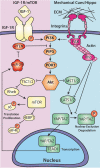Modeling the Tumor Microenvironment and Pathogenic Signaling in Bone Sarcoma
- PMID: 32057288
- PMCID: PMC7310212
- DOI: 10.1089/ten.teb.2019.0302
Modeling the Tumor Microenvironment and Pathogenic Signaling in Bone Sarcoma
Abstract
Investigations of cancer biology and screening of potential therapeutics for efficacy and safety begin in the preclinical laboratory setting. A staple of most basic research in cancer involves the use of tissue culture plates, on which immortalized cell lines are grown in monolayers. However, this practice has been in use for over six decades and does not account for vital elements of the tumor microenvironment that are thought to aid in initiation, propagation, and ultimately, metastasis of cancer. Furthermore, information gleaned from these techniques does not always translate to animal models or, more crucially, clinical trials in cancer patients. Osteosarcoma (OS) and Ewing sarcoma (ES) are the most common primary tumors of bone, but outcomes for patients with metastatic or recurrent disease have stagnated in recent decades. The unique elements of the bone tumor microenvironment have been shown to play critical roles in the pathogenesis of these tumors and thus should be incorporated in the preclinical models of these diseases. In recent years, the field of tissue engineering has leveraged techniques used in designing scaffolds for regenerative medicine to engineer preclinical tumor models that incorporate spatiotemporal control of physical and biological elements. We herein review the clinical aspects of OS and ES, critical elements present in the sarcoma microenvironment, and engineering approaches to model the bone tumor microenvironment. Impact statement The current paradigm of cancer biology investigation and therapeutic testing relies heavily on monolayer, monoculture methods developed over half a century ago. However, these methods often lack essential hallmarks of the cancer microenvironment that contribute to tumor pathogenesis. Tissue engineers incorporate scaffolds, mechanical forces, cells, and bioactive signals into biological environments to drive cell phenotype. Investigators of bone sarcomas, aggressive tumors that often rob patients of decades of life, have begun to use tissue engineering techniques to devise in vitro models for these diseases. Their efforts highlight how critical elements of the cancer microenvironment directly affect tumor signaling and pathogenesis.
Keywords: Ewing sarcoma; bone sarcoma; osteosarcoma; tumor models.
Conflict of interest statement
The authors declare no conflicts of interest.
Figures



References
-
- Hanahan D., and Weinberg R.A.. Hallmarks of cancer: the next generation. Cell 144, 646, 2011 - PubMed
Publication types
MeSH terms
LinkOut - more resources
Full Text Sources
Medical

